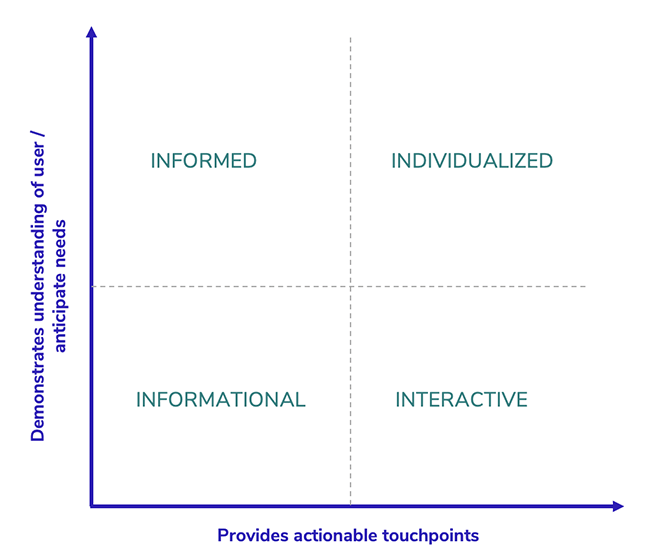Considering Needs and Actions to Create Meaningful Customer Experiences

When it comes to creating business value, customer experience matters. In fact, according to a 2019 report from Forrester, companies surveyed feel that improving customer experience is a greater priority than increasing revenue. This is a strong statement given that we’re all in the business of making money, but indicates that more and more companies see digital customer experiences as core to driving conversion, ensuring retention and loyalty, and creating value for their user base in general.
So how do you capitalize on that understanding? What makes for a good experience? And how can we talk about experience in a way that designers, engineers, and the business can all understand? After all, creating a great experience will require the buy-in and support of multiple departments.
Anticipate Needs and Enables Actions
Designers and engineers don’t always see things the same way, which means their priorities aren’t always the same on every project. But, these two groups are often critical stakeholders behind a project getting off the ground and completed successfully. So, if you want your project to be consistent, timely, and impactful, it’s critical to have a system in place for effective communication. Creating a common vocabulary can help to bring the complexity together and establish a system for communication.
The core of creating a common vocabulary, specifically for a user experience project, is understanding the two key elements that lead to a great experience, anticipating needs and enabling action.
Anticipate Needs
This represents a demonstrated understanding of who your customers are, aligning what they see with what they need and want. Ultimately this allows you to proactively customize experiences to provide users with what they want before they know they want it. Anticipating your users’ needs helps you and your team determine what’s really important to your user, and thereby the areas you should focus on for a specific project.
Enables Action
This represents the ability for users to do more than just navigate; rather it gives them the tools to control the experience and exposes how things work so that they can decide how to proceed. Once you have an understanding of what actions your user will want or need to take, you can focus on creating an experience that will help them take that action and ultimately meets their needs.
User Needs and Actions
To help frame the conversation in a way that everyone can understand and take away what they need, it can be helpful to consider the needs and actions of your users as two separate axes on a chart. Using the below chart can help you to describe a range of experiences and analyze your work to inform decisions and create moments that matter for your user.
Informational
If your user exists within this quadrant, then you have a generic understanding of their needs and minimal action beyond navigation is needed. This area represents a one-size-fits-all approach with no real differentiation.
Informed
In this quadrant, there’s a deep understanding of needs with minimal action needed. This represents a higher value interaction that may be auto-curated based on personas, segmentation, and individual behaviors and is still a fairly passive experience.
Interactive
There’s a generic understanding of needs within this quadrant, but the experience is highly actionable. This approach can involve exposing more than any individual might need to see but provides tools to wade through and pursue a unique path based on the information provided.
Individualized
If your user falls into this quadrant then you have a deep understanding of their needs and will need to create a highly actionable experience. This represents an effective and efficient interaction that enables users to get to their benefit quickly while giving them full control of the overall experience.
Let’s See How This Works
Once you have your users’ needs and actions mapped in the above chart, you can start to see how this can be helpful to describe a range of experiences from a brochure website to a fully interactive application. More importantly, it helps us analyze our work in a way to make the best decisions. Not every screen in an application, page on a site, or step in a journey will fall into the same quadrant.
Often, only a few moments really matter to our users and by identifying these moments we can build strong experiences that enable our audience to take action without getting in the way. By first considering the needs and actions of our users, it ensures we can focus the hardest work in the right places.
To help understand how to apply this thinking, let’s explore a possible experience for a known/loyal user booking a hotel room:
| Step | Quadrant |
|---|---|
| 1. Log in | INTERACTIVE: deep action, generic experience |
| 2. View loyalty/points status | INFORMED: user-specific but static information |
| 3. Search by date/location | INTERACTIVE: user takes control, generic experience |
| 4. Results, highlighting preferred room types | INFORMED: layers user preferences over generic, static experience |
| 5. View hotel/room details | INFORMATIONAL: generic room information |
| 6. Book with defaulted credit card and instructions | INDIVIDUALIZED: streamlined to accomplish task but allows override for full control |
| 7. Check-in; pick specific room (defaulted to learned preference) | INDIVIDUALIZED: guided by learned patterns but allows override for full control |
Different teams might apply this framework differently for the same flow, and that’s okay. The important part is using this to help think about what’s really important to your users and how to create the appropriate experience each step of the way.
Building Experiences That Truly Matter
Understanding your customers and their needs and actions can help you create a user experience that is tailored to your audience to drive conversion, ensure retention and loyalty, and create value for your user base. But, before you can do this, you must create a common vocabulary with your key stakeholders to frame the conversation in a way that everyone can understand and take away what they need. We hope this post provides you with a starting point to begin these conversations and start building experiences that truly matter to your audience.



